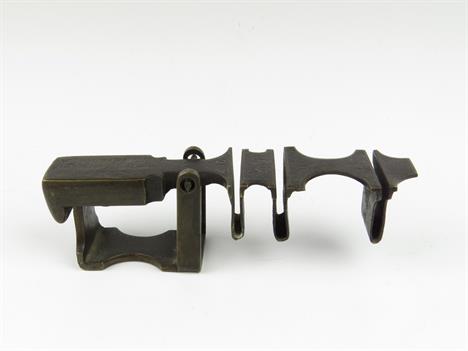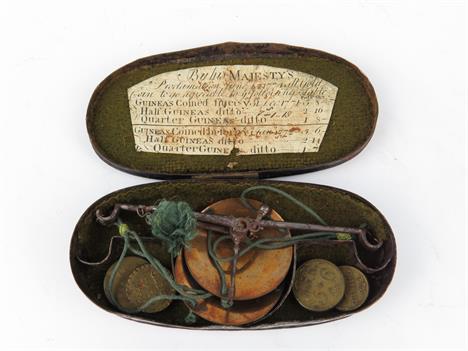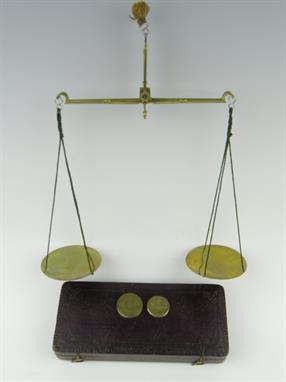Sampson Mordan & Co., a half-roberval type travelling steelyard, c.1865-1871, the letter tray stamped 'S. Mordan & Co, London', with sliding poise, contained within a red leather box, the lid impressed 'Travelling Letter Weigher', with gilt lettering verso 'W & J. Milne, Makers, 126 Prince's St, Edinburgh', capacity 2oz, scale 15cm (including tray)
We found 186097 price guide item(s) matching your search
There are 186097 lots that match your search criteria. Subscribe now to get instant access to the full price guide service.
Click here to subscribe- List
- Grid
-
186097 item(s)/page
A cast and sheet brass pendulum scale and stamp box combined, c.1887-1888, the cast rococo style base incorporating stamp box, the lid cast with a winged rider upon a hippocamp chasing a letter bearing dove, design registration No.67231 of 1887, with further hexagonal stamp initialled A*C, capacity 2oz, 15.7cm
Auguste Marion & Co., London, a brass and copper Wraggs patent pendulum scale, c.1865-1871, postage charge 1oz - 2d, upon a pierced 'A' frame with raised circular base, the rear support strut with oval stamped 'Marion, London', capacity 4oz, 19cm Auguste Marion & Co, to A E Ragg's patent UK No.2052 of 3 Aug 1871
Narcissé Briais, a French cast brass pendulum scale, c.1885-1890, with a circular dial, stamped to the centre 'N. B. Depose', the pierced base with levelling screw and scrolling decoration, capacity 100g, 20cm Narcissé Briais, Bellville, Siene (working 1856-1886), maker of many types of postal scales, for both the French & the British market. The stand version of Restorf's French patent No.171832 of 1885. His logo NB was used by subsequent owners of the firm (A E Ragg's patent UK No.2052 of 3 Aug 1871).
P. J. Maul, a set of gilt metal hand held pendulum scales, early 20th century, makers mark 'M' within form star, capacity 50g, 10cm and a Perry & Co, London, hand held brass pendulum scale, c.1870 (suspension loop and letter clip possible replacements), capacity 4oz, 9.5cm overall James Perry & Co (working 1831-1896), wholesale stationers, manufacturers of stationers' necessities. Exhibited at the Great Exhibition of 1851.
An American silver hand held pendulum scale, c.1865, (for the English market) postage rates for pre 1871, the suspension loop joined to an inverted cornucopia with scrolling decoration, the pointer upon a open beaded drop leading to a ball shaped poise, stamped sterling, capacity 5oz, 7cm long
Parnell, London, a fine gilded brass hand held Hall's Patent pendulum scale, 1863-1865 inscribed 'Parnell, London', with elaborate foliate scroll work, within original red leather case, with green velvet and silk lining, capacity 4oz, 12.3cm Ann Parnell, 283 Strand, London, ironmonger & locksmith (working c.1860-1871), bankrupt in 1871.
James Heeley & Son, a gilt brass Hall's second patent pendulum scale, c.1866-1871, the centre stamped for 'James Heeley & Sons, Sole Manufacturers, Birmingham', the dial with two pointers attached to a single poise for price and weight, the poise stamped 'Hall's second patent', Patent No.543 for 1866, capacity 2oz, 1 - 4d, 10.5cm James Heeley & Sons (working 1833-1876), steel toy manufacturers.
An ornate Gorham USA, sterling silver pendulum postal scale, date code for 1909, the decorative arc above a bird, a letter held within its beak, with an ornamental pendulum, struck verso 'Sterling B10', the pendulum struck 'Sterling and other metals', capacity 12oz, 16cm (including suspension loop)
Brook & Son, an ornate Scottish silver pendulum postal scale, Edinburgh, 1895, having a pierced scrolling fret work fan shaped arc, above a coronet and decorative pierced scroll work, with shaped pendulum, struck verso 'Brook & Son, 37 George St, Edinburgh', capacity 12oz, 16.5cm (including suspension loop) Brook & Son, 87 George St, Edinburgh (working 1892-1903), by appointment goldsmiths to Queen Victoria then to Edward VII.
Auguste Marion & Co, pendulum parcel scale, c.1883-1897, with pierced brass dial and subsidiary arc for indicating price on a decorative nickel plated stand, the pendulum with locking mechanism, upon an oak platform base with buffer and inset with spirit level, capacity 8lbs, 23cm wide, 35cm Auguste Marion & Co (working 1845-1902) in London & Paris, specialised in photographic materials, but had a stationery department. The scales bearing their name are different from every other design, having a little ball on the cogs and using two metals decoratively. CONDITION REPORT: the parcel tray slightly bent, the nickel stand has engraved leaf decoration
Wilcox Silver Plate Co., an American postal scale, c.1893, the rectangular body with beaded edge and dial, all supported upon ball feet, the mechanism struck to the underside 'Wilcox Silver Plate Co. - Meriden CT, Patent Jany. 24, 1893/ Sept. 5, 1893', with vacant dial aperture verso, capacity 10oz, 8.8cm high, 9cm wide
Pelouze Scale & MFG Co., two American spring balance postal scales, a 'Victor' c.1897, with celluloid dial inscribed for 'Pelouze Scale and MFG. Co., Chicago, copyright 1897', for weighing letters, books, circulars and news papers, and a nickel plated and steel dial faced postal scale, late 19th century, with paper dial inscribed for 'W. N. Pelouze, copyright 1897', rates for MDS, letters, books etc, capacity 24oz and 4lbs respectively , 11 cm and 14cm
Henry Hooper, a brass shelf edge postal bismar, with medallion form weight, the obverse with Royal Coat of Arms within a garter, and legend 'The Post Office Letter Weight', the reverse with crowned drapes for Roland Hill's plan of penny postage, for 'H. Hooper, 12 Aug. 1839, registered No.1, pursuant to 2 Vic. Ch. 17', measuring ½ - 4oz, and with sprung letter clip struck 'Hooper's Spring Holder, reg 68. 2.Vic C. 17', beam 16.3cm Henry Hooper, publisher (working 1828-1842), took out the first ever Design Registration in 1839. He made five versions of this scale ranging in price between 1/9 and 10/6, celebrating Rowland Hill's Penny Post. He advertised his letter weighers very widely in British newspapers in 1839 & 1840 and had many agents. He specialised in pamphlets, newspapers and magazines, running the organisation from his home, office at 13 Pall Mall East, and retailed at the Corner of Catherine Street with the Strand. He published pamphlets about contentious issues of a political nature. The medallions were made by Silvester & Co, 27 Strand, goldsmiths and engravers of seals and copper plates (working 1804-1843). Penny Post - Prior to 1839, the cost of sending a letter was charged by distance travelled and the number of sheets of paper. From 12 August 1839 onwards, the cost was determined by the weight of the letter irrespective of the length of its journey.
John Greaves & Son, a tubular spring postal scale, 19th century, with partially blued steel letter clip, the nickel plated tubular outer case stamped 'John Greaves & Son', with diamond trade mark and screw cap, capacity 4oz, 8.6cm John Greaves & Son, of South St, Sheffield, brass founders and steel converters, makers of tools (working 1839-1845). Made many variations of very small postal or coin scales using nickel-silver. Greaves advertised their postal scales Oct 1840.
Gervase Wheeler (London), a silver coloured metal tubular spring postal scale, c.1840-1865, the tubular case stamped 'G. Wheeler, London', capacity 2oz, 6.3cm Gervase Wheeler, silversmith & jeweller, warehouse and manufactory at Bartlett's Buildings, Holborn, London (working at least 1800-1840). After a huge burglary in 1833, valued at about £620, or £424,000 today, the chief culprit was publicly hanged.
W. Poupard & Co., a rare patinated brass rocker type letter balance, c.1840-1871, with three letter slots marked ½oz - 2oz, the counter weight cast 'W. Poupard & Co, Inventors and Makers, 30 Wych Street', 17cm W Poupard, scale maker, 'patentee and manufacturer of every description of scales, weights, platform and other weighing machines, etc'. From a large family of scale makers, not always successful. He went bankrupt in 1848, worked as a polishing powder maker as W Poupard & Co and occasionally as a coal dealer. He recovered and took his sons into the business in 1874.
Sampson Mordan & Co., a rare sterling silver set of miniature coin scales and weights, late 19th century, modelled as a roberval postal scale, with decorative pierced 'A' frame and central weight aperture upon a raised oval base with applied rope twist rim, the beam stamped 'STER-NG', with three original pennyweights, 3 and 2 penny weights and a 10 gram knobbed weight, 5cm wide, 5cm high
A George III coin scale, c.1775, the copper pans in an oval japanned case, with applied printed label inscribed 'By His Majesty's Proclamation, June 27th 1774...' with two guinea weights, one inscribed 'Coined before 1772' and two ½ guinea weighs one inscribed 'Coined since 1772', the other 'George III up to 1772', beam 10.1cm
A George III coin scale, with pressed brass circular pans, within a black japanned metal case, with two apertures housing guinea and ½ guinea weights, beam 10.6cm and a further coin scale, c.1775, within a faux tortoiseshell japanned case, with a guinea weight, beam 11.1cm CONDITION REPORT: George III coins scale - The beam in rusted condition
Two George III coin scales and weights, c.1775, each within an oval faux tortoiseshell japanned case, one having a circular guinea weight the other with two ½ and ¼ ounce trade weights, beams 11.8cm and 11cm CONDITION REPORT: First coin scale - half guinea weight missing, interior silk lining and cloth deteriorating, holes to tin, 50% of japanning to lid missing second coin scale - Weights later, japanning to base deteriorating
Hudson, a coin scale, c.1820, the turned beam stamped 'Hudson', within a bow fronted faux tortoiseshell and gilt floral decorated japanned case, with two apertures housing circular guinea and ½ guinea weights, beam 14.8cm Probably Robert Hudson, trained by Thomas Williams (working at least 1812-1824). CONDITION REPORT: Pointer repaired
A George III coin scale, c.1775, the circular beams with swan neck ends, within a faux tortoiseshell japanned oval case, the lid with applied paper label inscribed 'Saturday June 25th 1774, by His Majesty's Proclamation, issued in this days Gazette, it is ordered that no guineas, ½ guineas, or ¼ guineas wanting more than is specified in the following table, shall pass or be current after the 15 July next...', with a matching set of six circular brass guinea, ½ guinea and ¼ guinea weights, each struck with a coffee pot mark, for pre 1772 and post 1772 guinea, beam 10.5cm
Two George III coin scales, c.1775, one beam with box end terminals, within a black japanned oval case, with three circular guinea, ½ guinea and ¼ guinea weights, inscribed 'Coined before 1772', two further square penny weights and three grain weights, marked with either a coffee pot or a lion, the other with swan neck ends, within a japanned oval tin, with guinea and ½ guinea weights, marked 'Coined since 1772', beams 11.8cm and 12.1cm CONDITION REPORT: One scale has no material lining to interior of tin, steel scales rusted throughout and japanning on tin 30% deficient
Two George III coin scales, c.1775, the beams with box ends, one within a faux tortoiseshell japanned oval case, with a circular brass guinea weight, the other within a black japanned tin case, with two circular brass guinea and ½ guinea weights, beams 10.8cm and 12.3cm CONDITION REPORT: One scale has half guinea weight missing
Two George III coin scales, c.1775, the beams with box ends, within faux tortoiseshell japanned oval cases, the other with circular brass guinea and ½ guinea weights, beams 12cm and 11.9cm CONDITION REPORT: One scale has no weights the other has pointer reduced in height, rust to scale, lid silk lining deteriorating, some japanning missing
Two George III coin scales, the oval beams with box ends, within black japanned oval cases, one with three circular brass guinea, ½ guinea and ¼ guinea weights, the other with brass circular sovereign and ½ sovereign weights, beam 12.3cm and 12.1cm CONDITION REPORT: One scale with rust, interior lid severely distressed and deteriorating, some patches of japanning missing throughout the other scale steel is rusted throughout, silk lining missing to interior lid, patches of rust and loose japanning to the case
Johannes Linderman, a fine Dutch coin scale, 18th century, a silvered brass triangular pan and a dished circular pan, within a fruitwood cut from solid box, the interior lid with a coloured label, inscribed ' Dese Gewigte warden Gemaakt en verkogt by Johannes Linderman op de Beurs en op de Singel op de hoek van Corsjes steeg inde Goode Balans tot Amsterdam', the scales in a plush velvet interior with seven apertures housing nine square brass weights and with a sliding compartment enclosing four grain weights, a drawer to the base containing a further thirteen weights, each section with hand written denomination, a majority bearing Lindermann's master mark, some unmarked and one marked with initials 'WK', beam 10.9cm Johannes Linderman II (born 1700-died 1758) or Johannes Linderman III (born 1745-died 1806). As the acceptable language was sometimes Dutch and sometimes French, they used either Jan & Johannes. From a large family of scale makers in Amsterdam.
Young & Son, coin scales, early 19th century, the beam with box end terminals, within a mahogany case with trade label to the lid for 'Young & Son, Scale Makers to His Majesty, No.5 Bear Street, Leicester Square, London...', with apothecary weights, 2,1 and ½ dram, 2,1 and ½ scruple, and seven grain weights, all within a hinged tin and with loose waxed paper gold weight calculations, beam 12.6cm John Young bound to George Sewell, became his partner 1785-1801 and successor. Trained his son John Young II and took him into partnership as Young & Son 1811-1827, but the name continued in use until 1902. He had four other apprentices, none became masters. Maker to George III by 1809. Exhibited scales at the Great Exhibition 1851
Mary De Grave, coin scale, c.1818, the beam with box ends, within a mahogany box, the lid interior with applied label for 'Mary De Grave, Widow and Successor to the late Chas De Grave, Scale Maker to His Majesty, No.59 St Martin Le Grand, Corner of St Anns Lane Aldersgate...', the box interior lid hand inscribed in ink 'Jny 1 1818', with two square guinea weights and a ½ guinea weight, square sovereign and ½ sovereign weights, a square tapering 100 grains weight and a circular 7 shilling weight, beam 17.8cm Mary DeGrave (working alone 1800-1816) had two apprentices in her own right; one was her second son Edward Abraham DeGrave who worked alongside his mother for some years. Both made standard scales and weights for corporations, sometimes Edward Abraham would send the bill, sometimes Mary DeGrave & Son would. May have lived until 1861.
John Snart, a fine English coin scale, c.1700, within a fruitwood cut from solid box, having a decoratively stamped lid, the interior lid with label for 'John Snart, scale maker, living at the Heart and Scales in Maiden Lane, over against Goldsmiths Hall in London', with six assorted weights, beam 8.3cm John Snart I, scale maker (working 1693-died 1744), trained by Joseph Hart who died during his training. He had ten apprentices of whom six became masters. Auditor 1708, 1716 & 1717 (a greatly respected role) and Upper Warden (ie Master) of Blacksmiths' Co 1726 & 1727. Major in London Militia. On the Court of Common Council, representing Aldersgate Ward. Made the Standards for Scotland in 1707, after the Union and took orders for scales and weights for the Scottish Mint directly from Isaac Newton. Will survives. CONDITION REPORT: The square weight aperture has previously had a sliding lid of which now only the edge is present
Benjamin Martin, a rare ivory and silver plated hydrostatic Steelyard, c.1773, the beam inscribed 'Martin Fecit, No.3380', the silver end with two positions for the suspension clip, with a blued steel pointer, the ivory beam with a scale to each side, one for weighing guineas, the other graduated to thirty-six shillings for Portuguese money current in Britain, all housed within a cardboard and shagreen cap end case, 16.3cm Benjamin Martin, leading scientific instrument maker (working 1738-1777) in Fleet St, London. Lecturer, author, inventor of superb dividing engine. His scales retailed by booksellers in Colchester and Bury in 1773. CONDITION REPORT: suspension clip and sliding weight missing
Shakespeare's mulberry wood, Thomas Sharp, coin scale with box made from wood from Shakespeare's mulberry tree, the beam with swan's neck ends supporting two thick gauge pans, within a cut from solid mulberry wood case, finely decorated with fruiting vines, the central shield above a face mask, with further geometric decoration throughout, the interior lid stamped 'Shakespeare's Wood, Sharp, Stratford on Avon', housing three weights for guinea, ½ guinea and ¼ guinea, a further hexagonal mulberry wood grain weight box, the interior lid stamped 'Shakespeare's Wood, Sharp, Stratford on Avon', containing seven grain weights, beam 7.4cm, scale case 8.9cm, grain box 3.2cm diameter Thomas Sharp of Stratford on Avon, clock and watch maker and gunsmith, scale maker, silversmith, entrepreneur (born 1725- died 1799). Apprenticed as a clock maker in 1744. His 17 year old apprentice William Evans ran away in 1762. He catalogued the collection of provincial coins amd tokens of Sir Geo Chetwynd. Shakespeare's mulberry tree was cut down in 1756 by notorious Rev. F Gastrell. Sharp caused to be made from the tree, tea caddies, goblets, punch ladles, snuff boxes & many other articles, possibly by George Cooper, for sale to tourists. He suffered extreme pain from 'white swelling & a fractured leg' for over 40 years, until his death
-
186097 item(s)/page




























































